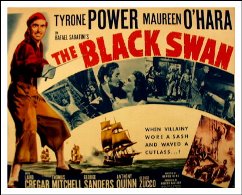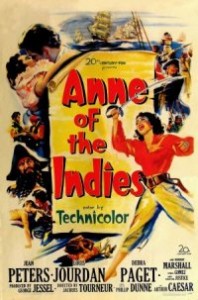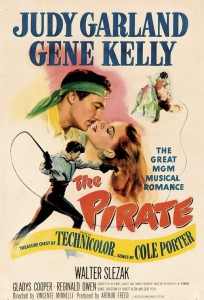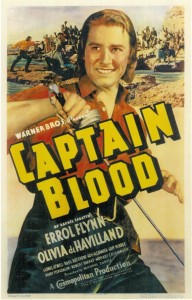 Using only the title of a Rafael Sabatini novel and one of its minor characters, Sir Henry Morgan, The Black Swan (1945) has the very things going for it that Against All Flags lacked—Tyrone Power, the next best swashbuckler after Flynn; that first-rate score, by Alfred Newman, that had eluded Salter; the Oscar-winning cinematography of Leon Shamroy, a notch or two above Metty’s. Quinn is also back, although he is succinctly out-swashed—or is it “out-buckled”?—by George Sanders’ very busy double. Power somewhat reprises the masculine half of his dual character, that of dandy/swordsman extraordinaire, in The Mark of Zorro (1940).
Using only the title of a Rafael Sabatini novel and one of its minor characters, Sir Henry Morgan, The Black Swan (1945) has the very things going for it that Against All Flags lacked—Tyrone Power, the next best swashbuckler after Flynn; that first-rate score, by Alfred Newman, that had eluded Salter; the Oscar-winning cinematography of Leon Shamroy, a notch or two above Metty’s. Quinn is also back, although he is succinctly out-swashed—or is it “out-buckled”?—by George Sanders’ very busy double. Power somewhat reprises the masculine half of his dual character, that of dandy/swordsman extraordinaire, in The Mark of Zorro (1940).
The actor, however, who practically steals the show—even Ty must be watchful of his laurels—is Laird Cregar as a ripsnortin’ Sir Henry Morgan, larger than life, of enormous girth and vigorous presence. Sabatini’s description of Morgan as “a middle-aged, overdressed man of an almost obese habit of body” is only partially true of Cregar, as the actor was only twenty-nine at the time of filming and not “obese” but simply large, as O’Hara indicated in her joint commentary with Rudy Behlmer. Cregar, “overdressed,” yes, seems to possess his every scene, addressing Power with a bellowing “Jamie Boy” and snatching from his head the black wig as if it were as much a part of him as his eyes or arms. Shamroy’s camera, too, seems intimidated by his height, serving only to emphasize his bearing, whether entering a tavern of merely dropping into a chair.
And then there’s that Newman music, complete with a sailors’ chorus, “Heave Ho,” behind the main title and reappearing in the orchestra in numerous variations throughout the film. A strident trumpet motif prevails much like a similar treatment of the same instrument in The Mark of Zorro, also scored by Newman.
As an example of the repartee in the film, there’s this early scene where the purple-clothed Don Miguel (Fortunio Bonanova), somewhat large of presence himself, has Jamie Waring (Power) on the rack:
“Where were you planning to meet Morgan?” Don Miguel asks.
“On the far side of the moon.”
“Where’s his ship?”
“Hulled down and sailing through you whiskers, Don Miguel.”
In reaction to distant cannon fire, Don Miguel wonders, “What is that?”
“The devil looking after his own.”
 By means of a correction in the process, The Crimson Pirate (1952) is a wonderfully comic approach to the pirate genre. Burt Lancaster and his friend, Nick Cravat, both with acrobatic experience, integrate circus stunts into their action scenes, and are supported by Torin Thatcher (again), Eva Bartok, Christopher Lee and Dana Wynter. James Hayter makes a quirky Professor Prudence. He, Lancaster and Cravat are chained to a longboat, which the professor intentionally tips over, keel up, surmising that a certain theory must be correct. Why, yes! Submerged, the men walk the harbor bottom to shore, surviving on the reservoir of air inside the boat.
By means of a correction in the process, The Crimson Pirate (1952) is a wonderfully comic approach to the pirate genre. Burt Lancaster and his friend, Nick Cravat, both with acrobatic experience, integrate circus stunts into their action scenes, and are supported by Torin Thatcher (again), Eva Bartok, Christopher Lee and Dana Wynter. James Hayter makes a quirky Professor Prudence. He, Lancaster and Cravat are chained to a longboat, which the professor intentionally tips over, keel up, surmising that a certain theory must be correct. Why, yes! Submerged, the men walk the harbor bottom to shore, surviving on the reservoir of air inside the boat.
William Alwyn’s score, though nothing really special, is nevertheless a utilitarian one, particularly the comic bassoon in the submerged longboat episode. In writing about Master and Commander on this website entitled Fire on the Up Roll! , I mistakenly credited Alwyn with the score of Disney’s Treasure Island; the music is, of course, by Clifton Parker.
I have to stop sometime, I suppose, though there are so many other pirate movies. I set out to cover only a small percent of the genre, but perhaps, now, a quick wrap-up with a few of the stragglers— There are the supposedly straightforward approaches, although the results are often unintentionally comic, films such as Tripoli (1950), the various Pirates of— Tortuga, Tripoli and Monterey (1961, 1955 and 1947, respectively); A High Wind in Jamaica (1965) and another “windy” flick, Fair Wind to Java (1953); and two versions of The Buccaneer (1938 and 1958), the former the better film, the latter with the better score, a highly extroverted one by Elmer Bernstein.
 Lady pirates? Jean Peters is rather unconvincing in Anne of the Indies (1951), and Gena Davis is equally miscast in Cutthroat Island (1995), though, to scrap the bottom of the barrel for something positive, Frank Langella’s menacing villainy is beyond reproach.
Lady pirates? Jean Peters is rather unconvincing in Anne of the Indies (1951), and Gena Davis is equally miscast in Cutthroat Island (1995), though, to scrap the bottom of the barrel for something positive, Frank Langella’s menacing villainy is beyond reproach.
Among the films intended to be comedies, there’s the presumed “serious” director Roman Polanski’s Pirates (1986), with an excellent go at it by Walter Matthau, more laid-back than usual as Captain’ Red. In Disney’s Blackbeard’s Ghost (1968), the old reprobate is summoned from the past to deal with a contemporary problem, Peter Ustinov doing his Blackbeard impersonation.
There was never a better escapist pirate movie, albeit a cartoon, than Disney’s Peter Pan (1953), followed years later by a horrid, unpleasant supposed “remake” (!) called Hook (1991). The Disney company, always ready to mine again an old cache, has created to great success the current series of Pirates of the Caribbean, already mentioned.
 There are the musicals The Pirate (1948), with Judy Garland and Gene Kelly, and The Pirates of Penzance (1983), a stylish take on Gilbert and Sullivan, made all the more sparkly by Linda Ronstadt and Angela Lansbury.
There are the musicals The Pirate (1948), with Judy Garland and Gene Kelly, and The Pirates of Penzance (1983), a stylish take on Gilbert and Sullivan, made all the more sparkly by Linda Ronstadt and Angela Lansbury.
To end, then. From among unlimited choices of supremely awful movies, three more piratical swashbucklers come to mind, intended, one would imagine, as spoofs: Swashbuckler (1976), its mediocre score by John Addison the “highlight”; The Pirate Movie (1982), with inept clichés from every swashbuckler ever made; and Yellowbeard (1983), one of James Mason’s last three films, sad to say.
 End of pirate flick discussions, did I say? . . . But what about Captain Blood (1935), generally regarded as the greatest pirate movie of ’em all? I wholeheartedly concur with that, and as for an exploration of same, that has been attended to on this website—and at some length, too—so please have a look at the separate review of Captain Blood.
End of pirate flick discussions, did I say? . . . But what about Captain Blood (1935), generally regarded as the greatest pirate movie of ’em all? I wholeheartedly concur with that, and as for an exploration of same, that has been attended to on this website—and at some length, too—so please have a look at the separate review of Captain Blood.
Since the bad films have become so depressing, perhaps something light to end. In the final scene of The Black Swan when “Tommie” Blue (Thomas Mitchell) and Sir Henry are admiring a sunset and salivating about the pirate life, Jamie comes on deck.
To “Tommie,” Morgan confides, “It wouldn’t take much arguing to talk me out of Jamaica [i.e., his governorship of the island]. Who wants to be sitting around stuffed with lace and a wig shutting the wind from your head?”
Then Lady Denby (O’Hara) appears, suggesting Jamie should be below decks, recovering from the wounds he sustained in the last battle. The two do the final, reconciliatory love scene, she saying the prerequisite “Jamie Boy” three times. All’s well, it appears. But is it?—
Morgan has the final word: “There he goes. . . . The end of the Spanish Main.”
.
Yes, if you’re looking for a serious pirate movie, Blackbeard with Robert Newton will disappoint. But if you want brilliant humorous dialogue and outrageous, appropriate hamming-it-up, this is the one movie that stands out, not just in the pirate genre, but in comedy in general. Pay attention to what Newton says, and to the foibles played by William Bendix and the character “Gilly.” And to the Dutchman, the insane beachcomber who proclaims “I am the king of Spain!”, and the characters picked to play the crew. What is often overlooked is the diversity in the crew. What a mix of races and seedy looking characters. Great casting. This movie is more than worth checking out.
I am looking for an old pirate movie with the actor Jacque Jacques. This movie was probably made in 1940/50. Can you help me?
…sure, THE pirate movie that catapulted Errol Flynn to stardom: “Captain Blood” with Olivia DeHavilland & Basil Rathbone.